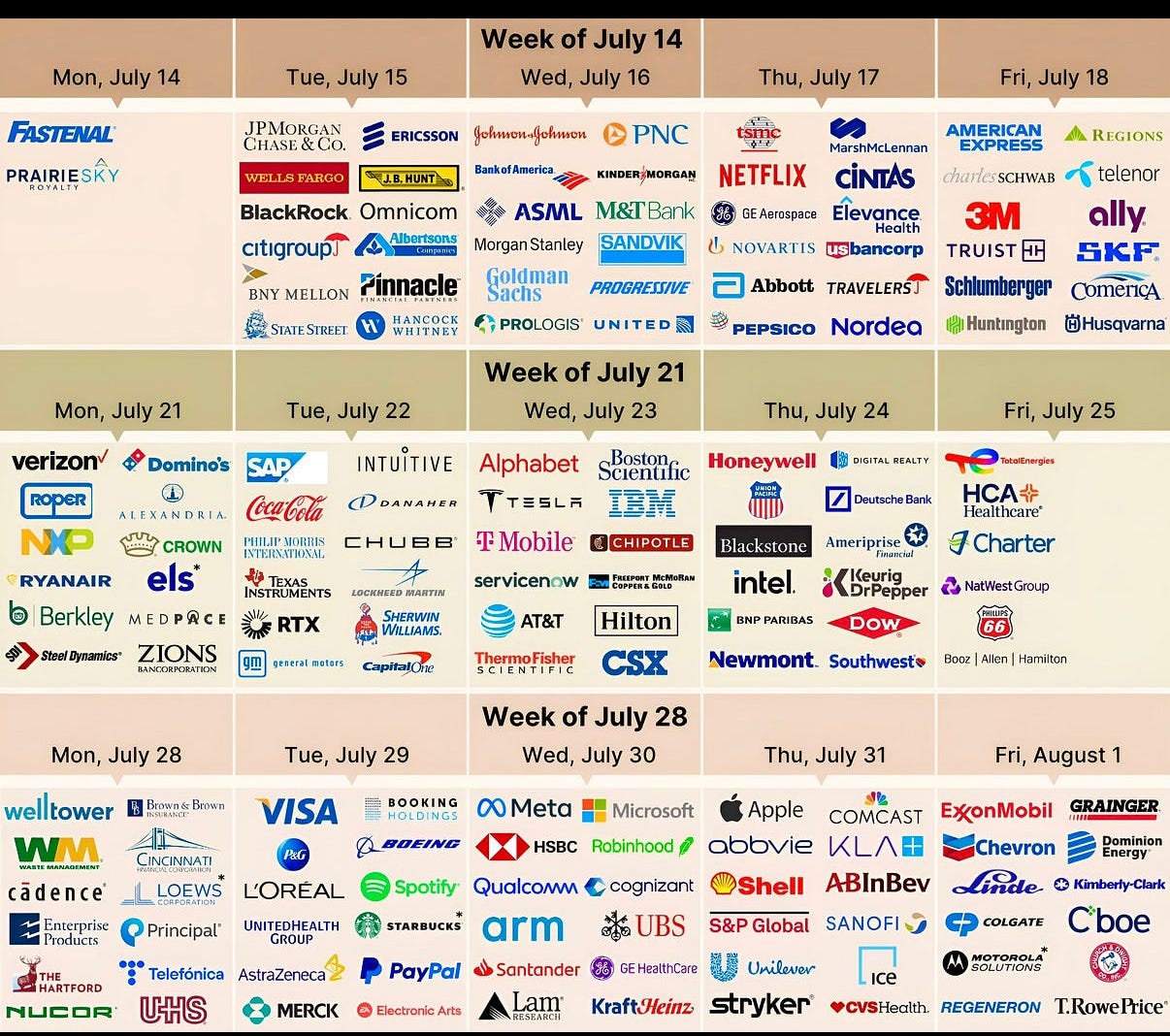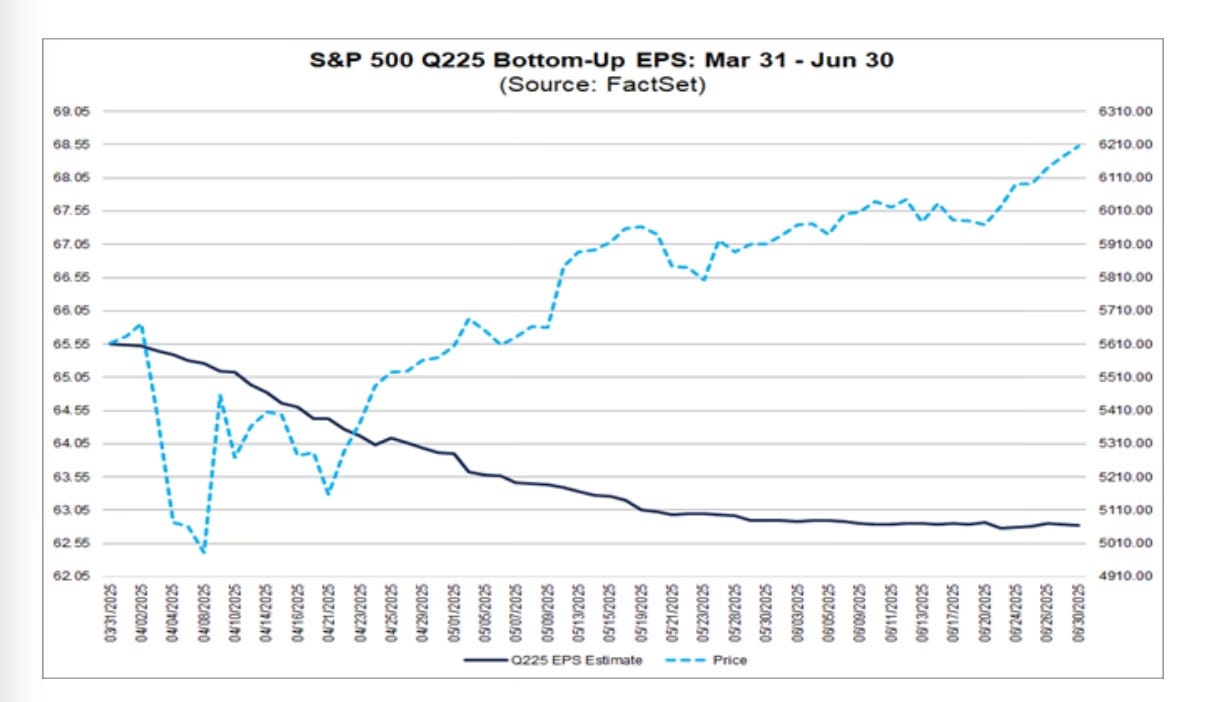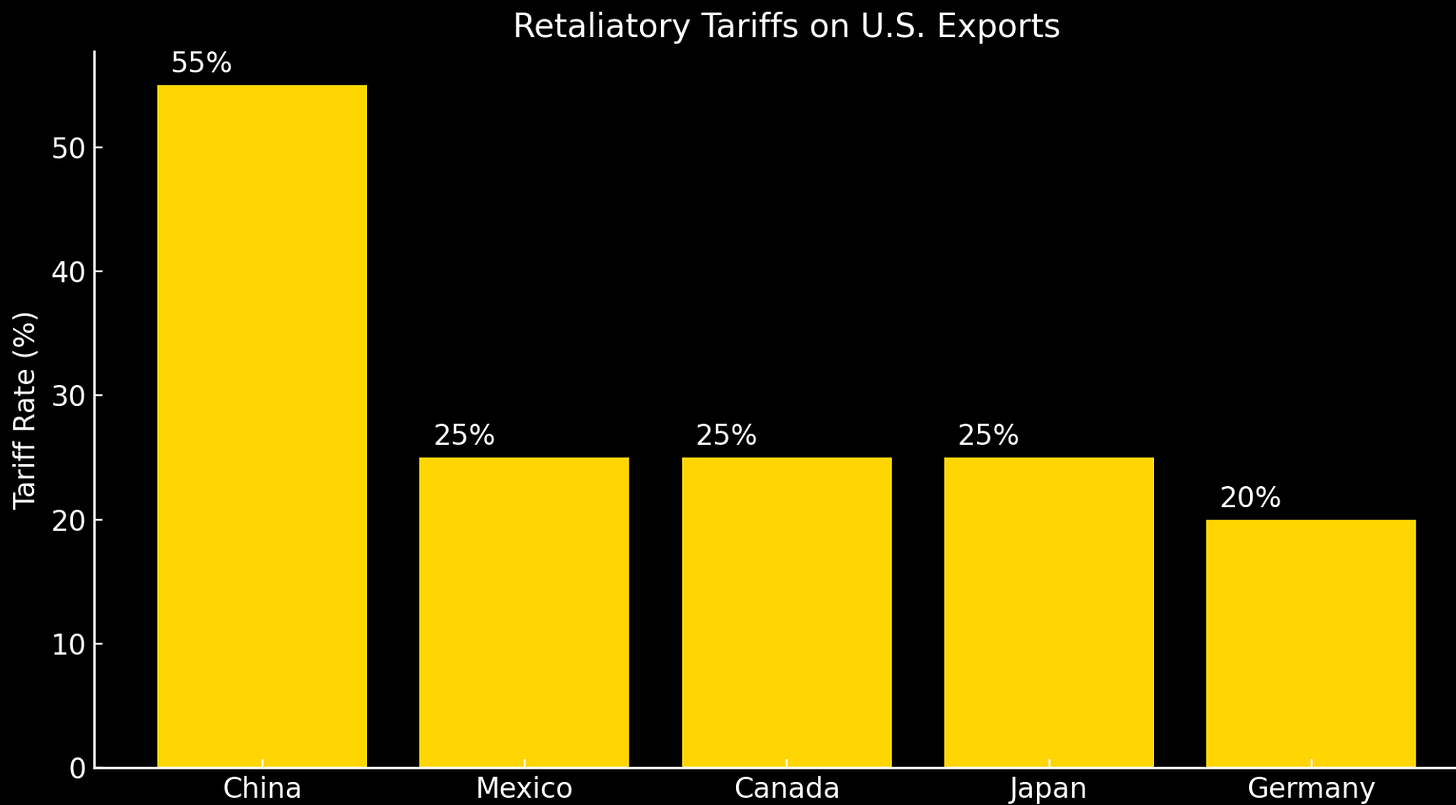Q2 Earnings Preview with Tariffs? Bueller?
“How did tariffs play out the last time we saw them globally? Anyone? Bueller?”
The stock market is drinking The Fed Liquidity dancing while the music is playing, with the Nasdaq leading the charge—fueled almost entirely by Nvidia’s record-breaking surge past a $4 trillion valuation. But behind this champagne-soaked narrative lies a minefield of economic risk. While speculators chase momentum, the first real earnings season under the weight of a sweeping global tariff regime is just beginning.
On April 5th, 2025, the Trump administration detonated a major shift in U.S. trade policy: a blanket 10% tariff on all imported goods. This wasn’t a tactical strike on a single sector or geopolitical rival—it was a full-spectrum levy on the goods that power U.S. supply chains, manufacturing inputs, and everyday consumption. The effects are only now beginning to ripple through corporate earnings, margins, and investor expectations.
And it didn’t stop there.
China was slapped with a 30% tariff—triple the universal rate. Steel and aluminum imports? 50% tariff. Cars and auto parts? 25%. Appliances containing steel? Also 50%. This is not a trade policy—it’s a wrecking ball. Each of these tariffs acts like a surcharge on US Stocks, driving up costs, shrinking margins, and forcing impossible decisions on corporations that rely on imported goods.
Now, for the first time, we’ll see those decisions play out in Q2 earnings.
And Wall Street’s already bracing. According to FactSet, S&P 500 analysts have cut earnings-per-share estimates by -4.2%—from $65.55 down to $62.83. That decline is larger than the 5-year, 10-year, and 15-year average downward revisions that typically occur during a quarter. Historically, such cuts average between 2.5–3%. This is a clear signal: Wall Street knows headwinds are forming.
The chart below shows stock rose while EPS fell, you’re not investing—you’re gambling on momentum. This is how bubbles form: shrinking earnings, surging prices, and speculators drunk on Fed liquidity —until the hangover the next day and just like in 1930… anyone? Bueller?……
At the sector level, the damage is broad. 10 out of 11 S&P sectors saw earnings downgrades. The energy sector leads the carnage with an expected -18% decline and material sector -12% in profits. This isn’t just a normal pullback—it’s a pre-earnings confession. And it’s likely just the beginning.
Meanwhile, the market pushes higher. As earnings forecasts fall, the S&P has ballooned to a 30× P/E and a 23× forward P/E—its highest valuation outside of the dot-com bubble.
These multiples are not just high. They are in clear bubble territory. And yet speculators keep buying as if the growth is going to double this year.
“In 1930, the Republican-controlled House of Representatives, in an effort to alleviate the effects of the... Anyone? Anyone?... the Great Depression, passed the... Anyone? The tariff bill? The Hawley-Smoot Tariff Act? Which, anyone? Raised or lowered?... raised tariffs, in an effort to collect MORE REVENUE for the Government. Did it work? Anyone know the effects? It did not work, and the United States sank deeper into the Great Depression. Today we have a similar debate over this. Anyone know what this is? Class? Anyone? Anyone? Anyone seen this before?”
In the film Ferris Bueller’s Day Off, the economics teacher’s lesson is ignored by a sleepy class. Today, the same scene plays out in financial markets. No one wants to talk about tariffs. No one wants to ask, “What happens next?” Because Nvidia stock which made up 30% of the overall stock market move since April has gone up.
But history answers. In 1930, the Hawley-Smoot Tariff Act was passed to protect American jobs. It raised tariffs across 20,000 imported goods. What followed was global retaliation, a -66% collapse in global trade, and a deepening of the Great Depression.
Today, we’re repeating the pattern. Already, China has responded with a 55% tariff on American exports. Mexico and Canada imposed 25%. Japan and South Korea: 25%. Germany: 20%. These are not theoretical retaliations—they are already active. And the next round of U.S. tariffs is scheduled for August 1st, including 25%–50% penalties on countries like Japan, South Korea, and Malaysia. The full effects of those won’t show until Q3.
Here’s where things get dangerous: most U.S. companies still haven’t passed tariff costs onto consumers. Levi’s, for example, said on its earnings call that it’s choosing to absorb the tariffs—corporate code for “we’re sacrificing margins.” But how long can that last? This is where President Trump’s strategy may backfire. He claims tariffs will incentivize companies to rebuild domestically—but so far, firms are paying the tariff, not repatriating production. So where does the promised job growth come from? It’s not showing up in the data. Continuing unemployment claims—tracking Americans who’ve lost jobs and haven’t found new ones—are up 8% since January. And the surge began right around the time tariffs kicked in this April. Since then, the trend has only accelerated.
Speculators stating that everything is fine, saying “these tariffs don’t matter” should look at wholesale inventories. Since April, inventories have fallen for three straight months—a rare contraction that hasn’t happened since 2020.
In March, inventories spiked—clear evidence companies were front-loading supply to avoid April tariffs. That’s not a healthy demand signal; it’s hoarding. And the fall since shows that real demand has cooled, likely due to rising prices and falling confidence.
Falling inventories mean businesses expect to sell less in the future. That’s an early recessionary signal. And in categories like electronics and durable goods—industries directly exposed to import tariffs—the slowdown is already pronounced.
So why is the market ignoring this?
Well, one, the Federal Reserve has loosened financial conditions by printing a total of $60 billion via three facilities: 1. The Discount Window ( as shown in the chart below)
2. Increase in overnight repurchase agreements, and 3. SOMA.
The Wall Street narrative by speculators is that Trump is bluffing with the tariff letters and there is no longer any downside risk. They remember April reversals. But April’s 10% tariff did go through. And now Trump has formally signed letters for the August 1st hikes. That’s not posturing. That’s policy.
“Did it work? Anyone? Anyone know the effects? It did not work, and the United States sank deeper into the Great Depression.”
Keep reading with a 7-day free trial
Subscribe to The Coastal Journal to keep reading this post and get 7 days of free access to the full post archives.











